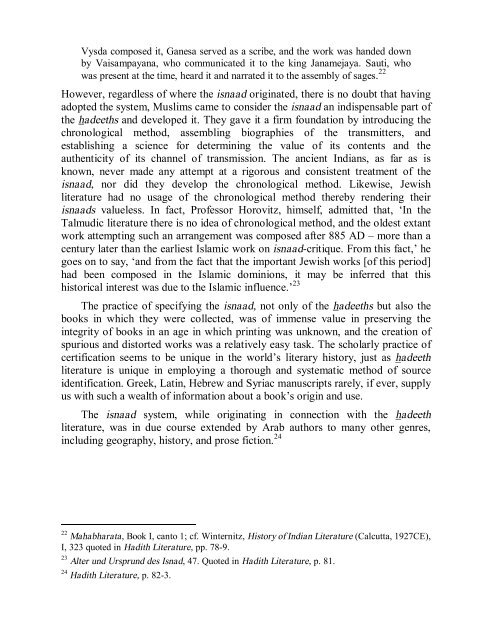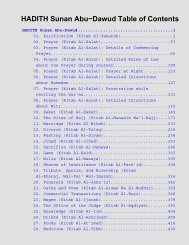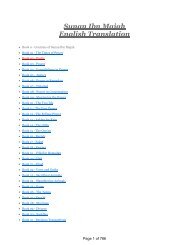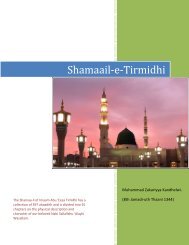You also want an ePaper? Increase the reach of your titles
YUMPU automatically turns print PDFs into web optimized ePapers that Google loves.
Vysda composed it, Ganesa served as a scribe, and the work was handed downby Vaisampayana, who communicated it to the king Janamejaya. Sauti, whowas present at the time, heard it and narrated it to the assembly of sages. 22However, regardless of where the isnaad originated, there is no doubt that havingadopted the system, Muslims came to consider the isnaad an indispensable part ofthe hadeeths and developed it. They gave it a firm foundation by introducing thechronologic<strong>al</strong> method, assembling biographies of the transmitters, andestablishing a science for determining the v<strong>al</strong>ue of its contents and theauthenticity of its channel of transmission. The ancient Indians, as far as isknown, never made any attempt at a rigorous and consistent treatment of theisnaad, nor did they develop the chronologic<strong>al</strong> method. Likewise, Jewishliterature had no usage of the chronologic<strong>al</strong> method thereby rendering theirisnaads v<strong>al</strong>ueless. In fact, Professor Horovitz, himself, admitted that, ‘In theT<strong>al</strong>mudic literature there is no idea of chronologic<strong>al</strong> method, and the oldest extantwork attempting such an arrangement was composed after 885 AD – more than acentury later than the earliest <strong>Islam</strong>ic work on isnaad-critique. From this fact,’ hegoes on to say, ‘and from the fact that the important Jewish works [of this period]had been composed in the <strong>Islam</strong>ic dominions, it may be inferred that thishistoric<strong>al</strong> interest was due to the <strong>Islam</strong>ic influence.’ 23The practice of specifying the isnaad, not only of the hadeeths but <strong>al</strong>so thebooks in which they were collected, was of immense v<strong>al</strong>ue in preserving theintegrity of books in an age in which printing was unknown, and the creation ofspurious and distorted works was a relatively easy task. The scholarly practice ofcertification seems to be unique in the world’s literary history, just as hadeethliterature is unique in employing a thorough and systematic method of sourceidentification. Greek, Latin, Hebrew and Syriac manuscripts rarely, if ever, supplyus with such a we<strong>al</strong>th of information about a book’s origin and use.The isnaad system, while originating in connection with the hadeethliterature, was in due course extended by Arab authors to many other genres,including geography, history, and prose fiction. 2422 Mahabharata, Book I, canto 1; cf. Winternitz, History of Indian Literature (C<strong>al</strong>cutta, 1927CE),I, 323 quoted in <strong>Hadith</strong> Literature, pp. 78-9.23 Alter und Ursprund des Isnad, 47. Quoted in <strong>Hadith</strong> Literature, p. 81.24 <strong>Hadith</strong> Literature, p. 82-3.





